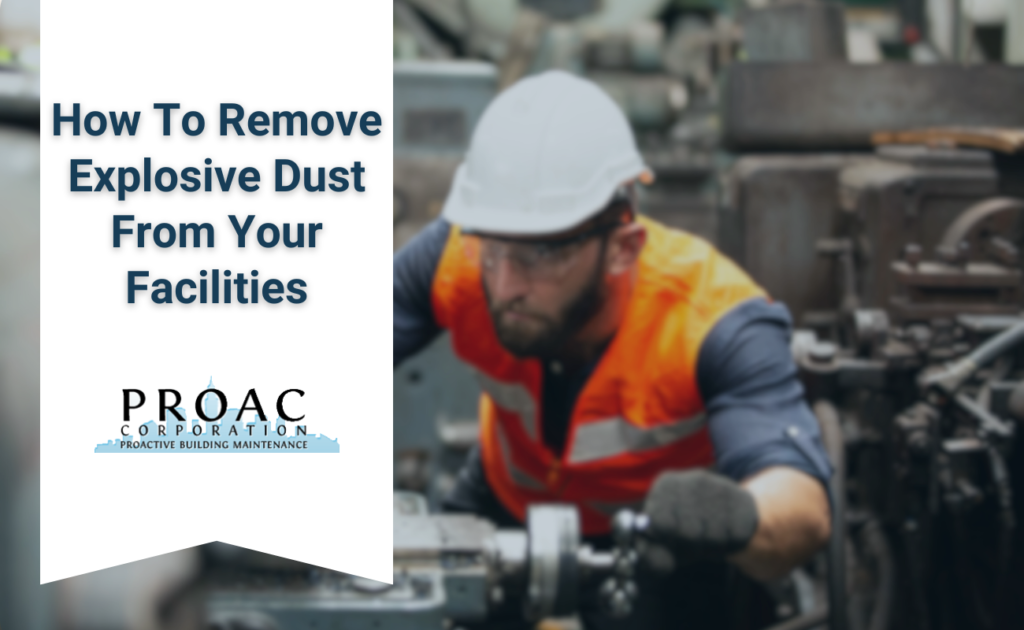Industrial and manufacturing facilities are often exposed to various forms of dust, many of which can be explosive if not handled correctly. Combustible dust poses serious safety risks, including the potential for devastating explosions. It is crucial to remove explosive dust from your facility, understand what explosive dust is, why it needs to be regularly cleaned from your facility, and the most effective ways to remove it.
What Is Explosive Dust?
Explosive dust refers to fine particles that can ignite under specific conditions, leading to fires or explosions when airborne. When these particles accumulate in industrial settings, they become a serious hazard. Combustible dust can come from a variety of solid materials, including:
- Wood
- Grains
- Sugar
- Flour
- Metal
- Dyes
- Fine Plastic Powder
- Powdered Milk
- Coal
- Some Nonmetallic Inorganic Materials
- Most Solid Organic Materials
These particles are typically found in facilities that handle raw materials or production processes that generate dust, such as wood processing plants, metalworking facilities, chemical manufacturers, and food production sites.
Why You Need To Regularly Clean & Remove Explosive Dust From Your Facility
The buildup of combustible dust in a facility can have severe consequences. Regular dust removal is important for several reasons, including:
- Fire and Explosion Hazards: Accumulated dust in enclosed spaces can be ignited by sparks or heat sources. These dust particles act as fuel, burning quickly and violently when in the air, which can lead to explosions.
- Compliance with Regulations: Authorities like OSHA and the National Fire Protection Association (NFPA) have clear guidelines for handling combustible dust. Failure to comply can result in fines, shutdowns, or legal liabilities in case of an incident.
- Equipment Efficiency: Dust accumulation can hinder equipment performance, clog ventilation systems, and reduce HVAC system efficiency. This not only leads to costly repairs but also increases energy consumption.
In addition to making your work environment safer, routine dust removal enhances the durability and performance of your equipment.
Ways To Remove Explosive Dust
There are numerous ways to remove explosive dust from your facilities:
- Dry Cleaning: Dry cleaning involves removing dust through traditional methods, like sweeping or wiping surfaces. However, this method can stir up dust, increasing the risk of it becoming airborne and igniting. To minimize risks, ensure there is adequate ventilation or containment while using dry cleaning for non-conductive materials.
- Wet Cleaning: Wet cleaning techniques use water to suppress and eliminate dust, reducing the chance that particles become airborne. This method works well for materials that don’t react with moisture.
- Vacuuming: Vacuuming is one of the safest methods for eliminating explosive dust when using vacuums specifically designed for combustible dust. Explosion-proof vacuums are grounded to prevent static discharge, which could otherwise ignite the dust.
- HEPA Filtration: High-Efficiency Particulate Air (HEPA) filtration captures fine dust particles that are too small to be seen but pose the greatest danger. HEPA filters can be used in vacuums or standalone air filtration units to ensure thorough cleaning.
- Enclosure Cleaning: Enclosure cleaning uses a sealed environment to contain dust during the cleaning process. This method is frequently used in sensitive locations where strict control over dust contamination is required.
Contact PROAC to Protect Your Facility
Don’t wait for a safety incident to demonstrate the importance of dust control. Set up an expert evaluation of your facility’s combustible dust hazards immediately. PROAC provides professional cleaning and maintenance services tailored to meet your unique requirements, ensuring your facility remains safe, efficient, and compliant. Contact us today to learn more about our industrial cleaning services and safeguard your building from the risks posed by explosive dust.
Contact us for our services throughout Pennsylvania as well as flammable dust removal in Harrisburg, PA. We perform explosive dust removal in Lancaster, PA as well as a variety of locations in PA. Our team based in Berks County PA removes combustible dust from manufacturing plants from Lebanon to Philadelphia.

